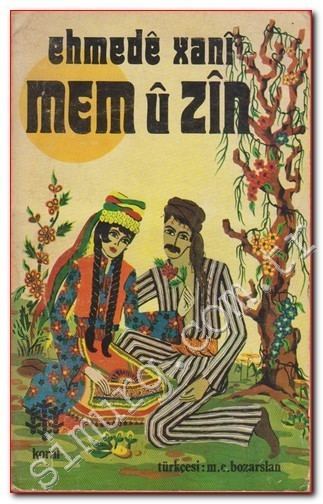Language Kurdish language Originally published 1692 Adaptations Mem û Zîn (1992) | Publication date 1692 | |
 | ||
Similar Sharafnama, Layla and Majnun, Alpamysh, Kinyas and Kayra, Masnavi | ||
Mam and Zin (Kurdish: Mem û Zîn) is a Kurdish classic love story written down 1692 and is considered to be the épopée of Kurdish literature. It is the most important work of Kurdish writer and poet Ahmad Khani (1651-1707). Mam and Zin is based on a true story, laid down from generation to generation through oral tradition. The content is similar to a Romeo and Juliet story. For Kurds, Mam and Zin are symbols of the Kurdish people and Kurdistan, which are separated and cannot come together. The Mem-u Zin Mausoleum in Cizre province has become a tourist attraction.
Contents
Synopsis
It tells the tragic story of two young people in love. Mem, a young Kurdish boy of the "Alan" clan & heir to the City of the West, who falls in love with Zin, of the "Botan" clan & the daughter of the governor of Butan. They meet during Festival of "Newroz" (the ancient national ceremony of Kurds) when the people are celebrating. Their union is blocked by Bakr of the Bakran clan, Mem’s antagonists throughout story, who is jealous of the two star-crossed lovers. Mem eventually dies during a complicated conspiracy by Bakr. When Zin receives the news, she collapses and dies while mourning the death of Mem at his grave. The immense grief leads to her death and she is buried next to Mem in Cizre. The news of the death of Mem and Zin spreads quickly among the people of Jazira Botan. When Bakr's (Beko) role in the tragedy is revealed, Tacdîn, the best friend of Mem, kills him. Bakr (Beko) will be buried next to Mem and Zin's graves. Because before dying, Zîn gives his testimony and says that "It was because of Beko that we could not come together, so I want him to witness our love, If he dies, bury him next to me and Mem". However, a thorn bush, nourished by the blood of Bakr, grows out of his grave: the roots of malice penetrate deep into the earth among the lovers’ graves, thus separating the two even in death.
Symbolic Meaning of the Main Characters
For modern Kurdish nationalists, Mam and Zin symbolize their struggle for a homeland. Mem represents the Kurdish people and Zin the Kurdish country, therefore both remain separated by unfortunate circumstances, and there can be no unity until they are reunited.
Texts
Among the various stories is the work of Ahmad Khani best known. Roger Lescot , a French Orientalist, added in the 1930s, the Meme Alan narrative with the help of several Kurdish Dengbêj singer from Syria. The forecast is partly historical roots, probably originated in the 14th century has been handed down by the Dengbêj. She describes in a precise and poetic language, the story of the ill-fated love of Mem and Zin. Against the background of chivalric traditions and social conventions .... This version is the version of the folk tale the next. The full version of the legend Meme Alan is now an integral part of the Kurdish literature.
Filming of the epic
On the basis of the book was in 1992 by Ümit Elçi film of the same Mem and Zin (dt. Mem and Zin ) rotated. Since the Kurdish language in Turkey was prohibited until the late 1990s / early 21st century, the Kurdish epic needed to be rotated in Turkish.
In 2002, the Kurdistan satellite channel Kurdistan TV produced a dramatised series of Memi Alan, Nasir Hassan, the director of the successful drama said, "Memi Alan" is the most substantial and the most sophisticated artistic work done. With a crew, more than 1000 people and 250 actors.
Literature
KOMKAR: Mam and Zin, Kurdish folk epic. In the version by Roger Lescot and L.-Lot Wentzel, Cologne 1995th
